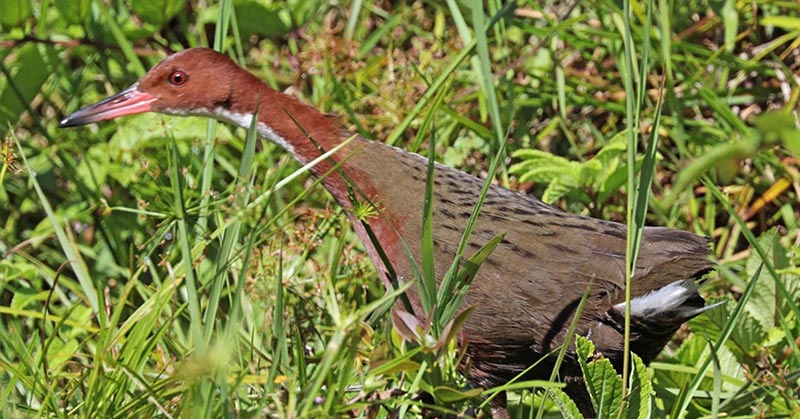The white-throated rail is a bird about the size of a chicken. It is native to Madagascar and tends to colonize individual islands, specifically an atoll called Aldabra, a ring-shaped reef in the Seychelle Islands. The reef had contained no predators for the rails, and eventually, they became flightless. They also became extinct 136,000 years ago when the atoll disappeared below sea level during a flood.
“Aldabra went under the sea and everything was gone,” said lead researcher Dr. Julian Hume, avian paleontologist and Research Associate at the Natural History Museum in London. “There was an almost complete turn over in the fauna. Everything … went extinct. Yet as the Aldabra rail still lives on today, something must have happened for it to have returned.”
Researchers have discovered this history through fossil evidence that was found after the sea levels fell during the following ice age. Since then, about 36,000 years later, the atoll has become recolonized by the rails, which seem to be back from the dead. Experts believe that the species has re-evolved itself into existence. Once settled on the atoll, they again lost their ability to fly.
This unbelievable evolution is occurring once again in the 21st century.
The Extinct Birds from the Aldabra Atoll are Back
Scientists from the Natural History Museum and the University of Portsmouth each determined that these birds have re-evolved themselves back into existence after comparing the ancient bones of the Aldabra rails to the second generation after the flood to the recently born birds. The latter includes the bones of flying rails and the flightless rails that currently co-habit the atoll. Their findings were published in the Zoological Journal of the Linnean Society. [1]
The researchers discovered that bones from before the flood were similar to the modern-day bird. They also found evidence that modern birds were evolving once again into flightlessness, for example, the ankle bone was stronger in the flightless birds when compared to the other birds that fly. This improved strength is a weight-bearing adaptation, indicating that they were getting heavier and unable to take flight. [2]
“These unique fossils provide irrefutable evidence that a member of the rail family colonized the atoll, most likely from Madagascar, and became flightless independently on each occasion,” said Hume. “Fossil evidence presented here is unique for rails, and epitomizes the ability of these birds to successfully colonize isolated islands and evolve flightlessness on multiple occasions.” [3]
The Aldabra rails are the only case found in history where the same species of bird have become flightless twice. According to Hume, “It wasn’t as if it were two different species colonizing and becoming flightless. This was the very same ancestral bird.” [4]
He describes this phenomenon as being possible due to “iterative evolution,” a process that occurs rarely that involves the evolution of “similar or parallel structures” from the same species or lineage that occurs at different points in time. Sophie Lewis from CBS News describes it as “a species can re-emerge over and over, despite past iterations going extinct.” [5]
“We know of no other example in rails, or of birds in general, that demonstrates this phenomenon so evidently,” said co-author Professor David Martill, from the School of Earth and Environmental Sciences at the University of Portsmouth. “Only on Aldabra, which has the oldest paleontological record of any oceanic island within the Indian Ocean region, is fossil evidence available that demonstrates the effects of changing sea levels on extinction and recolonization events.
“Conditions were such on Aldabra, the most important being the absence of terrestrial predators and competing mammals, that a rail was able to evolve flightlessness independently on each occasion.”
Read: Once Nearly Dead As The Dodo, California Condor Comeback Reaches 1,000 Chicks
The Aldabra Rails Face Predators Today
It’s unknown why the rails left Madagascar and emigrated to the atoll. However, every 50 or 100 years, overpopulation and food scarcity cause a mass migration of birds off of the island and across the Indian Ocean. The Aldabra rails are among the lucky ones who found a good new home.
The species is still vulnerable on the atoll where there are predators like cats and rats, but the Aldabra rail is the only flightless rail that currently lives in the Indian Ocean. The study shows how these birds tend to favor the evolution into flightlessness, at least when the environment is good.
“Evolution can be incredibly quick if the conditions are right,” said Hume. [6]
Keep Reading: Blue Whales Have ‘Unprecedented’ Bounce Back From Brink Of Extinction
[1] “Repeated evolution of flightlessness in Dryolimnas rails (Aves: Rallidae) after extinction and recolonization on Aldabra.” Julian P Hume, David Martill. Zoological Journal. July 2019
[2] “This Bird Evolved into Existence Twice — Thousands of Years Apart.” Yasemin Saplakoglu. Live Science. May 14, 2019
[3] “The bird that came back from the dead.” University of Portsmouth. Science Daily. May 9, 2019
[4] “Extinct Bird Re-Evolved Itself Back Into Existence.” Alexa Lardieri. US News. May 10, 2019
[5] “An extinct bird species has evolved back into existence, study says.” Sophie Lewis. CBS News. May 10, 2019
[6] “How Evolution Brought a Flightless Bird Back From Extinction.” Brigit Katz. Smithsonian Magazine. May 13, 2019

